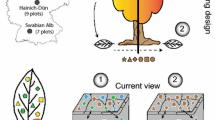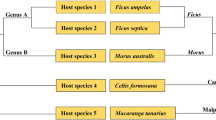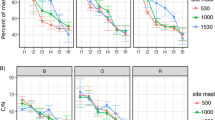Abstract
Aims
The fungal communities in living and decomposed leaves of European Beech (Fagus sylvatica) were compared to identify the phyllosphere fungi involved in litter decomposition at a site in Bavaria, Germany.
Methods
New primers were designed to cover a broad range of fungal ribosomal DNA sequence diversity. Following ‘environmental PCR’, clone libraries from each of five samples of living leaves (surface-sterilized and untreated), freshly fallen, initially and highly decomposed leaves, were screened using RFLP fingerprinting.
Results
Statistical analysis (ANOSIM) revealed that the fungal communities colonizing living (a) and initially decomposed leaves (c) significantly differed between each other and from freshly fallen (b) and highly decomposed leaves (d). Fungal assemblages of a and d were statistically indistinguishable from each other and from the endophyllous fungal community in living leaves.
Conclusions
The results showed that endophyllous fungi play a role throughout the whole decomposition process of beech leaf litter. Therefore, clarification of the life cycle of certain endophytic and/or soil fungi may only be achieved by considering both phyllosphere and soil habitats.



Similar content being viewed by others
References
Baldrian P, Lindahl B (2011) Decomposition in forest ecosystems: after decades of research still novel findings. Fungal Ecol 4:359–361
Baldrian P, Kolařík M, Stursová M, Kopecký J, Valášková V, Větrovský T, Žifčáková L, Šnajdr J, Rídl J, Vlček C, Voříšková J (2011a) Active and total microbial communities in forest soil are largely different and highly stratified during decomposition. ISME J. doi:10.1038/ismej.2011.95
Baldrian P, Voříšková J, Dobiášová P, Merhautová V, Lisá L, Valášková V (2011b) Production of extracellular enzymes and degradation of biopolymers by saprotrophic microfungi from the upper layers of forest soil. Plant Soil 338(1):111–125
Berg B, McClaugherty C (2008) Plant litter: decomposition, humus formation, carbon sequestration. Springer, Berlin, Heidelberg
Bills GF, Christensen M, Powell MJ, Thorn G (2004) Saprobic soil fungi. In: Mueller GM, Bills GF, Foster MS (eds) Biodiversity of fungi: inventory and monitoring methods. Elsevier, Boston, pp 271–302
Borneman J, Hartin RJ (2000) PCR primers that amplify fungal rRNA genes from environmental samples. Appl Environ Microbiol 66:4356–4360
Bridge PD, Spooner BM (2001) Soil fungi: diversity and detection. Plant Soil 232:147–154
Bridge PD, Roberts PJ, Spooner BM, Panchal G (2003) On the unreliability of published DNA sequences. New Phytol 160:43–48
Bringmark E (1989) Spatial variation in soil-pH of beech forests in relation to buffering properties and soil depths. Oikos 54:165–177
Brock PM, Döring H, Bidartondo MI (2009) How to know unknown fungi: the role of a herbarium. New Phytol 181:719–724
Buée M, Reich M, Murat C, Morin E, Nilsson RH, Uroz S, Martin F (2009) 454 pyrosequencing analyses of forest soils reveal an unexpectedly high fungal diversity. New Phytol 184:449–456
Câmara MPS, Palm ME, van Berkum P, O’Neill NR (2002) Molecular phylogeny of Leptosphaeria and Phaeosphaeria. Mycologia 94:630–640
Chapman MG, Underwood AJ (1999) Ecological patterns in multivariate assemblages: information and interpretation of negative values in ANOSIM tests. Mar Ecol Prog Ser 180:257–265
Coleman DC, Crossley DA Jr, Hendrix PF (2004) Fundamentals of soil ecology, 2nd edn. Academic, Burlington
Collado J, Platas G, Paulus B, Bills GF (2007) High-throughput culturing of fungi from plant litter by a dilution-to-extinction technique. FEMS Microbiol Ecol 60:521–533
d’Annunzio R, Zeller B, Nicolas M, Dhôte J-F, Saint-André L (2008) Decomposition of European beech (Fagus sylvatica) litter: combining quality theory and 15N labelling experiments. Soil Biol Biochem 40:322–333
R Development Core Team (2008) R: a language and environment for statistical computing. R Foundation for Statistical Computing. Vienna, Austria. http://www.R-project.org
Dickie IA (2010) Insidious effects of sequencing errors on perceived diversity in molecular surveys. New Phytol 188:916–918
Espinosa-Garcia FJ, Langenheim JH (1990) The endophytic fungal community in leaves of a coastal redwood population – diversity and spatial patterns. New Phytol 116:89–97
Flessa F, Kehl A, Kohl M (2010) RFLPtools. R package version 1.0
Frankland JC (1998) Fungal succession – unravelling the unpredictable. Mycol Res 102:1–15
Gardes M, Bruns TD (1993) ITS primers with enhanced specificity for basidiomycetes – application to the identification of mycorrhizae and rusts. Mol Ecol 2:113–118
Gewin V (2006) Genomics: discovery in the dirt. Nature 439(7075):384–386
Hashizume Y, Fukuda K, Sahashi N (2010) Effects of summer temperature on fungal endophyte assemblages in Japanese beech (Fagus crenata) leaves in pure beech stands. Botany 88:266–274
Heilmann-Clausen J, Christensen M (2003) Fungal diversity on decaying beech logs – implications for sustainable forestry. Biodivers Conserv 12:953–973
Jaccard P (1901) Étude comparative de la distribution florale dans une portion des Alpes et des Jura. Bull Soc Vaudoise Sci Nat 37:547–579
Johnston P (1998) Leaf endophytes of manuka (Leptospermum scoparium). Mycol Res 102:1009–1016
Jumpponen A, Jones KL (2010) Seasonally dynamic fungal communities in the Quercus macrocarpa phyllosphere differ between urban and nonurban environments. New Phytol 186:496–513
Kaneko R, Kaneko S (2004) The effect of bagging branches on levels of endophytic fungal infection in Japanese beech leaves. For Pathol 34:65–78
Kharwar RN, Gond SK, Kumar A, Mishra A (2010) A comparative study of endophytic and epiphytic fungal association with leaf of Eucalyptus citriodora Hook., and their antimicrobial activity. World J Microbiol Biotech 26:1941–1948
Koide K, Osono T, Takeda H (2005) Colonization and lignin decomposition of Camellia japonica leaf litter by endophytic fungi. Mycoscience 46:280–286
Korkama-Rajala T, Müller MM, Pennanen T (2008) Decomposition and fungi of needle litter from slow- and fast-growing Norway spruce (Picea abies) clones. Microb Ecol 56:76–89
Kurtzman CP, Fell JW, Boekhout T (2010) The yeasts, a taxonomic study. Elsevier, New York
Lee DW, Collins TM (2001) Phylogenetic and ontogenetic influences on the distribution of anthocyanins and betacyanins in leaves of tropical plants. Int J Plant Sci 162:1141–1153
Liers C, Arnstadt T, Ullrich R, Hofrichter M (2011) Patterns of lignin degradation and oxidative enzyme secretion by different wood- and litter-colonizing basidiomycetes and ascomycetes grown on beech-wood. FEMS Microbiol Ecol 78:91–102
Lindahl BD, Ihrmark K, Boberg J, Trumbore SE, Hogberg P, Stenlid J, Finlay RD (2007) Spatial separation of litter decomposition and mycorrhizal nitrogen uptake in a boreal forest. New Phytol 173:611–620
Lindeberg G (1946) On the decomposition of lignin and cellulose in litter caused by soil-inhabiting Hymenomycetes. Arkiv Bot 33A:1–10
Lorenzi E, Lorando E, Picco AM (2006) Microfunghi endofitici ed epifitici di Picea abies (L.) Karst. in ambiente natural ed antropizzato in Lombardia. Forest 3:426–436
Magri D, Vendramin GG, Comps B, Dupanloup I, Geburek T, Gomory D, Latalowa M, Litt T, Paule L, Roure JM, Tantau I, van der Knaap WO, Petit RJ, de Beaulieu JL (2006) A new scenario for the quaternary history of European beech populations: palaeobotanical evidence and genetic consequences. New Phytol 171:199–221
Manter DK, Vivanco JM (2007) Use of the ITS primers, ITS1F and ITS4, to characterize fungal abundance and diversity in mixed-template samples by qPCR and length heterogeneity analysis. J Microbiol Meth 71:7–14
Miyamoto T, Igarashi T, Takahashi K (2000) Lignin-degrading ability of litter-decomposing basidiomycetes from Picea forests of Hokkaido. Mycoscience 41:105–110
Moorhead DL, Sinsabaugh RL (2006) A theoretical model of litter decay and microbial interaction. Ecol Monogr 76:151–174
Nagahama T, Hamamoto M, Nakase T, Shimamura S, Horikoshi K (2006) Phylogenetic relationship within the Erythrobasidium clade: molecular phylogenies, secondary structure, and intron positions inferred from partial sequences of ribosomal RNA and elongation factor-1 alpha genes. J Gen Appl Microbiol 52:37–45
Osono T (2002) Phyllosphere fungi on leaf litter of Fagus crenata: occurrence, colonization, and succession. Can J Bot 80:460–469
Osono T (2006) Role of phyllosphere fungi of forest trees in the development of decomposer fungal communities and decomposition processes of leaf litter. Can J Microbiol 52:701–716
Osono T (2008) Endophytic and epiphytic phyllosphere fungi of Camellia japonica: seasonal and leaf age-dependent variations. Mycologia 100:387–391
Osono T, Takeda H (1999) Decomposing ability of interior and surface fungal colonizers of beech leaves with reference to lignin decomposition. Eur J Soil Biol 35:51–56
Osono T, Takeda H (2001) Organic chemical and nutrient dynamics in decomposing beech leaf litter in relation to fungal ingrowth and succession during 3-year decomposition processes in a cool temperate deciduous forest in Japan. Ecol Res 16:649–670
Parrott D, Yang L, Shama L, Fischer AM (2005) Senescence is accelerated, and several proteases are induced by carbon “feast” conditions in barley (Hordeum vulgare L.) leaves. Planta 222:989–1000
Peršoh D, Theuerl S, Buscot F, Rambold G (2008) Towards a universally adaptable method for quantitative extraction of high-purity nucleic acids from soil. J Microbiol Meth 75:19–24
Peršoh D, Melcher M, Flessa F, Rambold G (2010) First fungal community analyses of endophytic ascomycetes associated with Viscum album ssp. austriacum and its host Pinus sylvestris. Fungal Biol 114:585–596
Peršoh D, Weig AR, Rambold G (2012) A transcriptome-targeting EcoChip for assessing functional mycodiversity. Microarrays 1:25–41. doi:10.3390/microarrays1010025
Polisky B, Greene P, Garfin DE, McCarthy BJ, Goodman HM, Boyer HW (1975) Specificity of substrate recognition by the EcoRI restriction endonuclease. PNAS 72:3310–3314
Polz MF, Cavanaugh CM (1998) Bias in template-to-product ratios in multitemplate PCR. Appl Environ Microbiol 64:3724–3730
Promputtha I, Lumyong S, Dhanasekaran V, McKenzie EH, Hyde KD, Jeewon R (2007) A phylogenetic evaluation of whether endophytes become saprotrophs at host senescence. Microbial Ecol 53:579–590
Prosser JI (2010) Replicate or lie. Environ Microbiol 12:1806–1810
Pruesse E, Quast C, Knittel K, Fuchs BM, Ludwig W, Peplies J, Glöckner FO (2007) SILVA: a comprehensive online resource for quality checked and aligned ribosomal RNA sequence data compatible with ARB. Nucleic Acids Res 35:7188–7196
Santamaria J, Bayman P (2005) Fungal epiphytes and endophytes of coffee leaves (Coffea arabica). Microbial Ecol 50:1–8
Saunders M, Kohn LM (2009) Evidence for alteration of fungal endophyte community assembly by host defense compounds. New Phytol 182:229–238
Schubert K, Groenewald JZ, Braun U, Dijksterhuis J, Starink M, Hill CF, Zalar P, de Hoog GS, Crous PW (2007) Biodiversity in the Cladosporium herbarum complex (Davidiellaceae, Capnodiales), with standardisation of methods for Cladosporium taxonomy and diagnostics. Stud Mycol 58:105–156
Šnajdr J, Cajthaml T, Valášková V, Merhautová V, Petránková M, Spetz P, Leppänen K, Baldrian P (2011) Transformation of Quercus petraea litter: successive changes in litter chemistry are reflected in differential enzyme activity and changes in the microbial community composition. FEMS Microbiol Ecol 75:291–303
Staab JF, Balajee SA, Marr KA (2009) Aspergillus section Fumigati typing by PCR-restriction fragment polymorphism. J Clin Microbiol 47:2079–2083
Stone JK, Polishook JD, White JF (2004) Endophytic fungi. In: Mueller GM, Bills GF, Foster MS (eds) Biodiversity of fungi: inventory and monitoring methods. Elsevier, Boston, pp 241–270
Taylor JW, Jacobson DJ, Kroken S, Kasuga T, Geiser DM, Hibbett DS, Fisher MC (2000) Phylogenetic species recognition and species concepts in fungi. Fungal Genet Biol 31(1):21–32
Tedersoo L, Nilsson RH, Abarenkov K, Jairus T, Sadam A, Saar I, Bahram M, Bechem E, Chuyong G, Koljalg U (2010) 454 Pyrosequencing and Sanger sequencing of tropical mycorrhizal fungi provide similar results but reveal substantial methodological biases. New Phytol 188:291–301
Troedsson T, Tamm CO (1969) Small-scale spatial variation in forest soil properties and its implications for sampling procedures: Variabiliteten i några av skogsmarkens egenskaper inom små ytor och dess betydelse för markprovtagningsmetodiken. In: Flower-Ellis JGK (ed) Studia forestalia Suecica. Skogshögskolan, Faculty of Forest Sciences, Swedish University of Agricultural Sciences, Stockholm
Unterseher M (2011) Diversity of fungal endophytes in temperate forest trees. In: Pirttilä AM, Frank AC (eds) Endophytes of forest trees – biology and applications. Springer, Netherlands, pp 31–46
Unterseher M, Schnittler M (2009) Dilution-to-extinction cultivation of leaf-inhabiting endophytic fungi in beech (Fagus sylvatica L.) – different cultivation techniques influence fungal biodiversity assessment. Mycol Res 113:645–654
Unterseher M, Reiher A, Finstermeier K, Otto P, Morawetz W (2007) Species richness and distribution patterns of leaf-inhabiting endophytic fungi in a temperate forest canopy. Mycol Prog 6:201–212
Unterseher M, Jumpponen A, Opik M, Tedersoo L, Moora M, Dormann CF, Schnittler M (2011) Species abundance distributions and richness estimations in fungal metagenomics – lessons learned from community ecology. Mol Ecol 20:275–285
van Elsas JD, Garbeva P, Salles J (2002) Effects of agronomical measures on the microbial diversity of soils as related to the suppression of soil-borne plant pathogens. Biodegradation 13:29–40
White TJ, Bruns T, Lee S, Taylor J (1990) Amplification and direct sequencing of fungal ribosomal RNA genes for phylogenetics. In: Innis M, Gelfand D, Shinsky J, White T (eds) PCR protocols: a guide to methods and applications. Academic, London, pp 315–322
Wildman HG, Parkinson D (1979) Microfungal succession on living leaves of Populus tremuloides. Can J Bot 57:2800–2811
Zeier J (2005) Age-dependent variations of local and systemic defence responses in Arabidopsis leaves towards an avirulent strain of Pseudomonas syringae. Physiol Mol Plant Pathol 66:30–39
Žifčáková L, Dobiášová P, Kolářová Z, Koukol O, Baldrian P (2011) Enzyme activities of fungi associated with Picea abies needles. Fungal Ecol 4:427–436
Acknowledgments
We appreciate the support given by Ulrich Mergner (Ebrach) in allocating the sampling site. Dominik Begerow and Andrey Yurkov (both Bochum) shared with us details on Erythrobasidiaceae. Fabienne Flessa and Alexandra Kehl provided valuable information concerning data analysis, Sebastian Werner and Christina Leistner assisted with laboratory work (all Bayreuth). Suggestions of Marc Stadler (Bayreuth) helped to improve the manuscript.
Author information
Authors and Affiliations
Corresponding author
Additional information
Responsible Editor: Duncan D. Cameron.
Electronic supplementary material
Below is the link to the electronic supplementary material.
Table S1
Details on the assignment to RFLP types, genotypes and taxa of selected sequences. The most similar sequence found in GenBank is given in the following section. The assigned name is listed in the third part, together with the “Bit Score” of the worst matching sequence considered for the name assignment. The sequences considered for name assignment (i.e. sequences obtaining “Bit Scores” which are at least 0.9 times as high as the “Bit Score” obtained by the best matching sequence), are categorized as matches (i.e. sequences deposited under names matching the assigned name), ambiguities (i.e. sequences deposited under names neither confirming nor objecting the assigned name), and the number of outliers (i.e. sequences deposited under names not considered for the name assignment). (XLS 39 kb)
Table S2
Fraction of sequences in selected taxa matched by the primer sequences. The percentage of sequences matched perfectly (0 MM) and with one mismatch (1 MM) by the primers among the checked sequences (N) is given. (DOC 38 kb)
Rights and permissions
About this article
Cite this article
Peršoh, D., Segert, J., Zigan, A. et al. Fungal community composition shifts along a leaf degradation gradient in a European beech forest. Plant Soil 362, 175–186 (2013). https://doi.org/10.1007/s11104-012-1271-y
Received:
Accepted:
Published:
Issue Date:
DOI: https://doi.org/10.1007/s11104-012-1271-y




